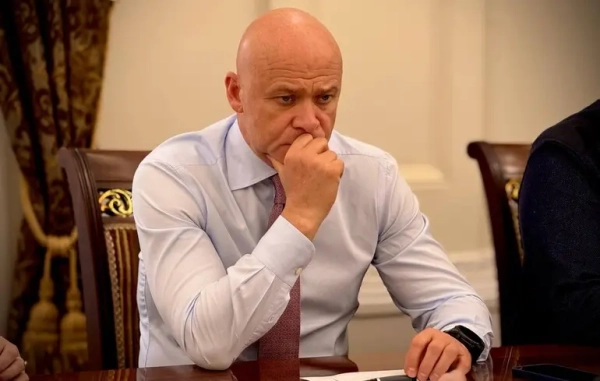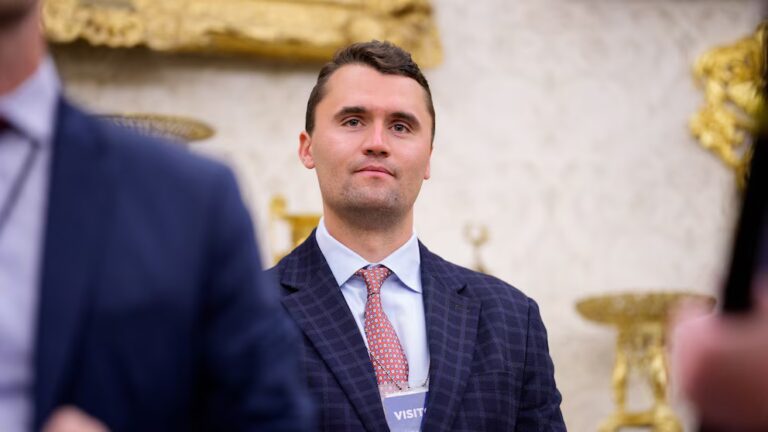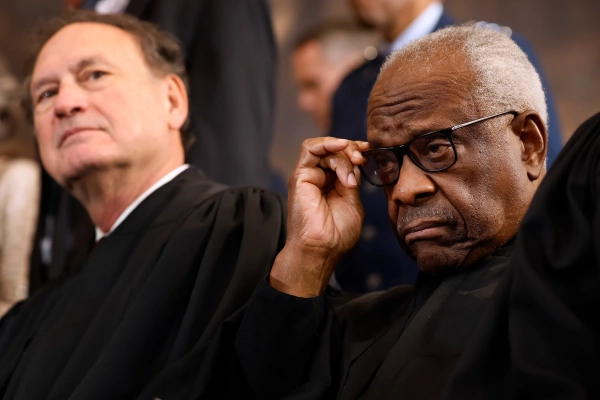Why did Ross Perot do so well in 1992? And could something like that happen again in 2024?
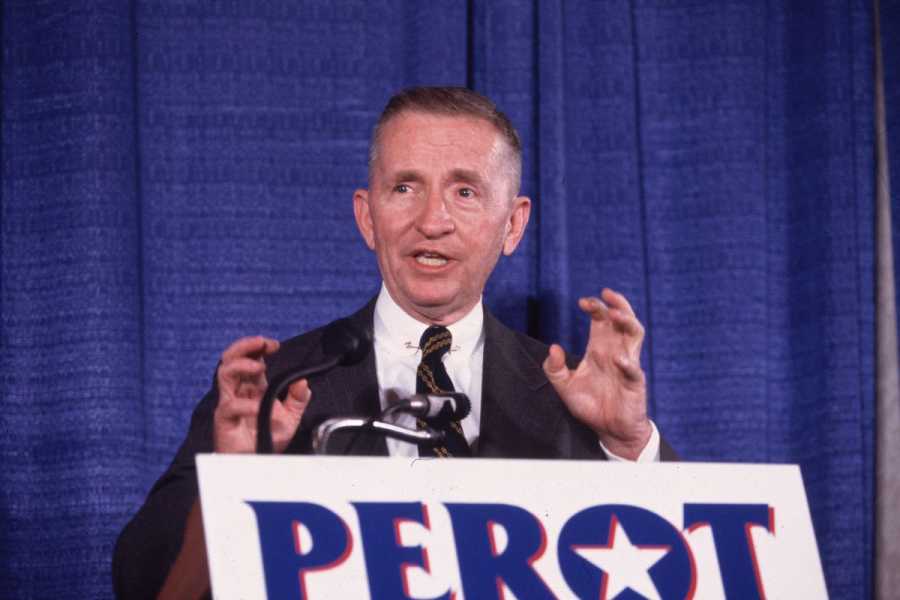
Ross Perot, then an undeclared candidate for president, at a press conference in early 1992. Arnold Sachs/Consolidated News Pictures/Getty Images Andrew Prokop is a senior politics correspondent at Vox, covering the White House, elections, and political scandals and investigations. He’s worked at Vox since the site’s launch in 2014, and before that, he worked as a research assistant at the New Yorker’s Washington, DC, bureau.
Americans were dissatisfied with both major-party options for president. The incumbent was viewed as prioritizing foreign affairs while failing to address voter dissatisfaction with the economy back home. The challenger was dogged by scandal. There was a palpable yearning for someone else. So a third-party contender entered the race — and was received with raucous enthusiasm, shooting to first place in the polls.
The year was 1992, and the third-party candidate was billionaire businessman Ross Perot. Obviously, Perot didn’t end up winning. But he had what now stands as the strongest performance for a third-party presidential candidate in the past century — he got nearly 19 percent of the vote nationally.
Now dissatisfaction with the two likely major party nominees is mounting again — a recent Monmouth poll found that 69 percent of registered voters said they were “not too enthusiastic” or “not enthusiastic at all” about a rematch between Joe Biden and Donald Trump. Some third-party candidates are already in the race; others may follow. And some polls have shown Robert F. Kennedy Jr. around Perot’s level of support.
So why did Perot catch on in 1992? And could something like his semi-success — or even beyond it — happen again next year?
Unlike ideological fringe third-party candidates, Perot ran as a populist centrist challenging the two parties. But he ran in a very different political environment — one of less polarization between the parties, where voters felt less terrified about the horrors that the “other side” winning might bring about.
We can think of the prospects for an independent candidate to have an unlikely success as depending on two conditions. First, have lots of people become disillusioned with the major parties? Second, have they lost their fear of the party they most dislike winning — concluding, essentially, that it doesn’t even matter which of the two parties wins? If both sentiments are widespread, as they were in 1992, an independent candidate will have better prospects for success (and more formidable candidates will be more likely to get into the race).
For 2024, the first condition is present: Lots of people are frustrated with the two likely nominees. But it’s not clear whether the second condition — the lack of fear of “the other side” winning — will be in place by November. There simply are greater differences between Democrats and Republicans today than there were during the Bush-Clinton race. The question is whether voters will recognize that.
What happened during Ross Perot’s 1992 presidential campaign
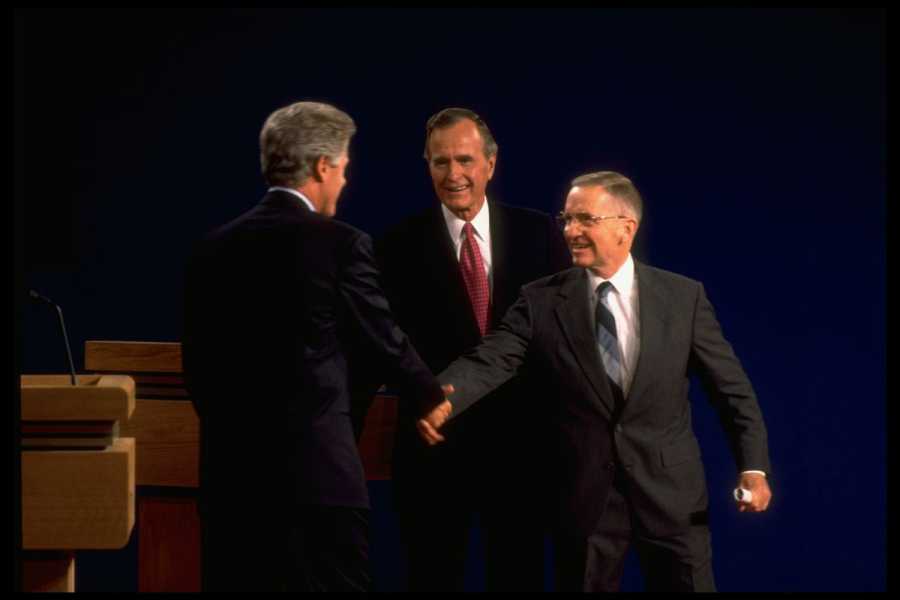
Perot (right) shakes hands with Bill Clinton as then-President George H.W. Bush looks on during the third presidential debate of 1992. Dirck Halstead/Getty Images
For much of 1991, President George H.W. Bush looked unstoppable. He’d racked up major foreign policy successes with the dissolution of the Soviet Union and the Gulf War intervention. In March 1991, Gallup recorded his approval rating at 89 percent, one of the highest numbers it had ever recorded. But as the year came to an end and attention turned to the weak US economy, Bush started looking more vulnerable. Arkansas Gov. Bill Clinton seemed to be the emerging frontrunner in a scattered Democratic field, but a sex scandal and draft-dodging allegations cast shadows over his campaign.
Enter Perot. The billionaire businessman, who had made his fortune in computer and IT services, had long gotten media attention as an opinionated entrepreneur with a Texas twang. CNN host Larry King had heard that people around Perot were hoping he’d get into the presidential race as an independent, and on February 20, 1992, he invited Perot on his program to quiz him: Why won’t you run? After initially demurring, Perot said that, if the American people helped him get ballot access in all 50 states, he would run. It kind of went viral — volunteers and donations poured in, more media followed, and polls soon found him drawing significant support in a three-way race.
Perot ran against the two parties, denouncing Washington corruption and governance failures (his new party would be called the Reform Party). His persona was that of a populist businessman: He had economic credentials but didn’t talk like an elitist or a typical politician. His major issue was the deficit — Washington wasn’t doing enough to cut it and, he said, he would. He also opposed the bipartisan establishment’s position on trade (saying if NAFTA were approved, it would lead to a “giant sucking sound” of American jobs going to Mexico) and foreign policy (arguing that the Gulf War was in part the US’s fault).
Much of this sounds in retrospect like foreshadowing of future Republican politics, with elements of both the anti-spending Tea Party wave of 2010 and Trump’s first campaign in 2016. But in one major difference, Perot’s campaign was not distinguished by nativism or demagoguery. Pat Buchanan was mounting that sort of campaign in his GOP primary challenge to Bush that year. Perot’s message, in contrast, was almost quaintly focused on economic wonkery — famously, he aired 30-minute “infomercials” about his economic plan that got surprisingly high ratings. Many of his supporters were middle-income but not college-educated, feeling at home in neither party.
By June, polls showed Perot actually winning — with 37 percent of the national vote, compared to 24 percent for Bush and 24 percent for Clinton — but this wouldn’t last long.
Scrutiny of Perot’s history and character intensified, with journalists covering his penchant for conspiracy theories and his frequent use of private detectives and surveillance. Critics denounced him as a kook or even a budding fascist. He made gaffes on hot-button social issues, saying he wouldn’t appoint any gay Cabinet officials (before reversing himself), and referring to Black Americans as “you people” at an NAACP meeting. And, he believed, opposing campaign operatives were trying to manufacture dirt about his family. So in mid-July, having fallen back down to third place in the polls, Perot quit the race.
Yet there was one last twist: In October, a month before the election, Perot jumped back in (since his supporters had already ensured he’d be on the ballot in every state). He qualified for the debates, where his performances were well-received. And he ended up with that 19 percent support nationally — not enough to win even one state, but the best third-party performance by popular vote since former President Theodore Roosevelt’s 1912 bid.
For decades, Republicans have claimed that Perot’s candidacy ended up acting like a “spoiler,” preventing Bush from winning. But Clinton had a large lead on Bush in polls during those months before Perot reentered the race — indeed, Perot’s reentry was viewed by some as Bush’s best hope for victory, since it would split the anti-incumbent vote. Furthermore, exit polls showed Perot supporters split between Bush and Clinton as their second-choice candidate, with only a slight advantage for Bush — not enough to flip the outcome.
Why hasn’t there been another Perot?
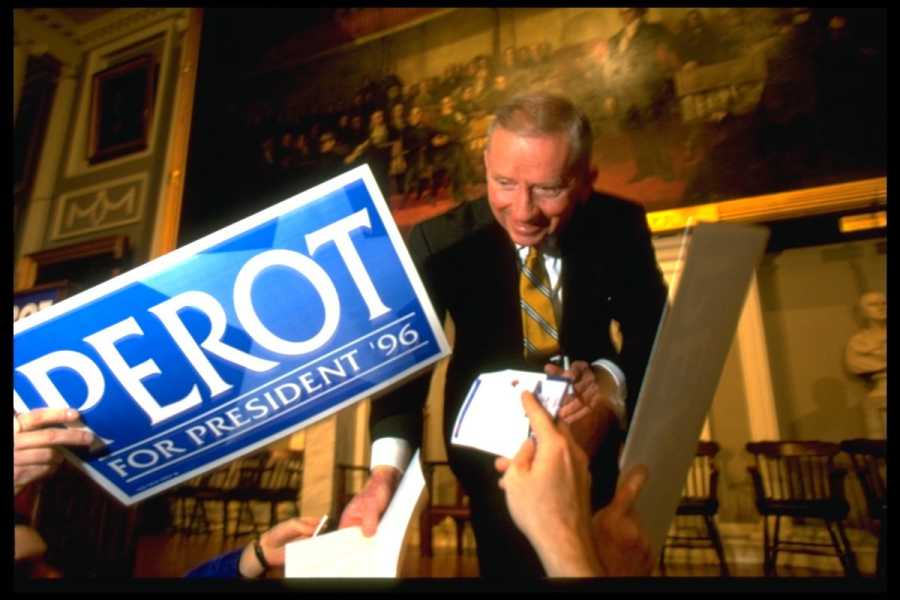
Ross Perot during his 1996 presidential campaign in Boston. Brooks Kraft LLC/Sygma via Getty Images
Perot was a sort of populist centrist, running down the middle, trying to draw about equal numbers of votes from the two parties, running on competence and “getting things done.” And though he ran for president again in 1996, he could not replicate his strong performance — he got 8.4 percent of the vote that time. No third-party or independent candidate has come close to even that level of support since. Indeed, the only such bids of significance have been from ideologically niche parties, the Greens and the Libertarians.
So why hasn’t something similar happened again? Well, part of the answer is that something similar has happened again — Trump.
Trump, of course, was not a third-party candidate, running instead as a Republican. He also centered his campaign around demagoguery over immigration, unlike Perot. But he was a populist billionaire businessman who didn’t talk like a traditional politician, acted erratically, was condemned as a potential authoritarian threat, ran on a “drain the swamp” campaign, and questioned the bipartisan consensus on trade and foreign policy. Trump’s campaign clearly satisfied the demand for one type of a Perot-like figure.
Additionally, Perot’s semi-success may have inadvertently revealed the limits of the independent path — after all, he did not win a single state. In 1998, Reform Party candidate and former pro wrestler Jesse “the Body” Ventura did manage to win a plurality in the Minnesota governor’s election. But to win the presidency, you need an Electoral College majority. And if no candidate gets a majority — for instance, if there’s a three-way split in states — the election would be settled by the partisan-dominated House of Representatives.
But a more structural explanation may be that, in retrospect, Perot’s 1992 campaign looks like a phenomenon of an era of lower political polarization and lower partisan threat.
At the time of that election, Republicans had controlled the presidency for 12 years. But Democrats had controlled the House of Representatives for 38 years, and the Senate for six, so governance was often by bipartisan consensus. Ideologically, that year, Bush was a relatively moderate Republican, and Clinton was running as a distinctly moderate Democrat. The vibes were that both parties were alike — and that it didn’t matter who won. If you felt that way, there was little risk in tossing your vote to a third party.
Things soon changed. A new breed of more radical Republicans took over Congress in the 1994 midterms, escalating partisan battles and pursuing ideological showdowns. Partisan loyalties among voters hardened, 2000 kicked off the current era of closely contested “red vs. blue” presidential contests, and partisan combat has only gotten more intense since.
Intuitively, you might think that as the two parties get more polarized, the prospects for a down-the-middle centrist candidate would grow more promising. Practically, that’s not so clear, because of the spoiler question. In US federal and statewide elections, any third-party candidate — and any potential third-party voter — has to deal with the possibility that, by following their heart rather than picking the lesser of two major-party evils, they may help the greater evil win. (Supporters of ranked-choice voting have a fix for that, but that’s a policy debate for another article.) During the George W. Bush administration, there was much finger-pointing from liberals at people who voted for Ralph Nader rather than Al Gore in 2000, and this experience likely suppressed third-party energy on the left for some time.
In recent years, negative partisanship — dislike and even fear of the other major party — has risen dramatically. Basically, there are a whole lot more solidly “anti-Democrat” and “anti-Republican” voters now than there were in decades prior. Because of that, at every level of the political system, from elites to voters themselves, there’s an intense desire not to help “the other side” win, and fear of what the other side winning would mean. Fewer voters are willing to gamble on a third-party centrist, which leads to fewer such candidates running at all.
In 2016, there were calls for a centrist “Never Trump” Republican to run, but in the end, only a litlte-known figure, Evan McMullin, got in, pulling 0.5 percent of the vote nationally. Then, as 2020 approached, former Starbucks CEO Howard Schultz thought he saw a path to winning the presidency as a centrist independent. But he faced withering criticism that his bid would only help reelect Trump, and he eventually decided not to run at all.
Could an independent candidate catch fire in 2024?
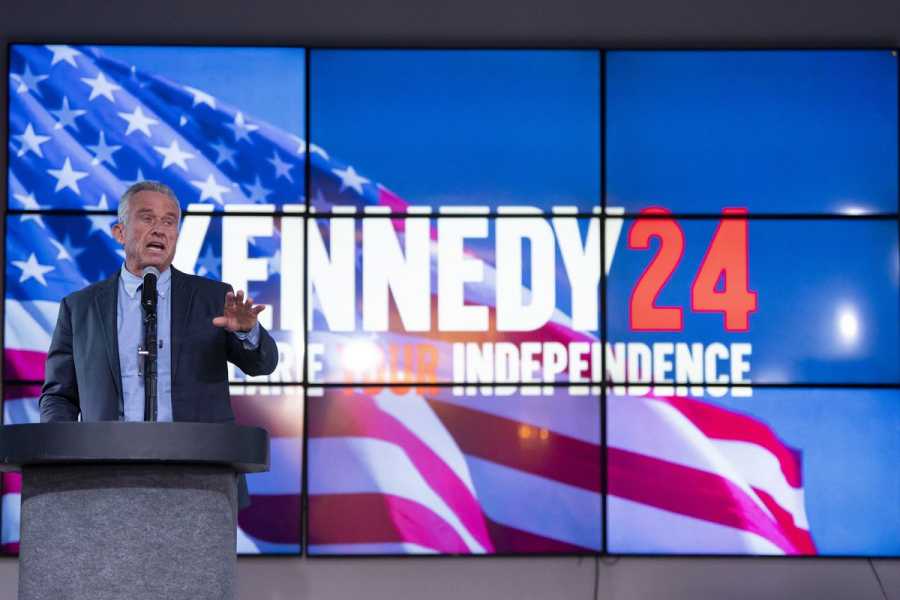
Independent presidential candidate Robert F. Kennedy Jr. speaks during a campaign rally at Legends Event Center on December 20, 2023, in Phoenix, Arizona. Rebecca Noble/Getty Images
Yet now it’s Biden, not Trump, in office and facing dramatically low approval ratings. And there are echoes of George H.W. Bush’s presidency in Biden’s; each was a former vice president (picked by a more charismatic president) with a longtime focus on foreign policy who faced doubts about his ability to handle the economy and dissatisfaction among elements of his party’s base.
Meanwhile, there is now an independent candidate who regularly polls in the double digits — Robert F. Kennedy Jr.
Like Perot, Kennedy is making a populist pitch to voters disenchanted with both parties, he has a rhetorical mode that’s very different from the typical politician, and he has a penchant for conspiracy theories. He does not have Perot’s business track record or economic credentials, but he does have a famous last name.
Kennedy, like any independent candidate, faces the formidable challenge of actually getting his name on the ballot in all 50 states — an expensive, time-consuming, and difficult process. (The group No Labels has also been exploring the possibility of backing a centrist presidential candidate, and is undertaking an effort to get on the ballot in many states.)
But in recent months, polls offering Kennedy as an option have shown him pulling between 12 and 22 percent in a three-way race with Trump and Biden. Many have speculated that these numbers are inflated by respondents who don’t know much about him but do like the last name — and that, as the stakes of a Trump-Biden general election and Kennedy’s own kookiness become clearer, voters will line up behind one of the major-party contenders accordingly.
That may well happen. But Perot’s performance shows it isn’t inevitable — that a third-party or independent candidate, even an erratic and conspiratorial one, can get a significant chunk of the vote. The question is whether more voters are now tuning out the constant warnings of the other side’s victory being such a dangerous threat — or concluding that’s a risk they’re willing to take.
Sourse: vox.com
